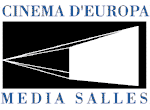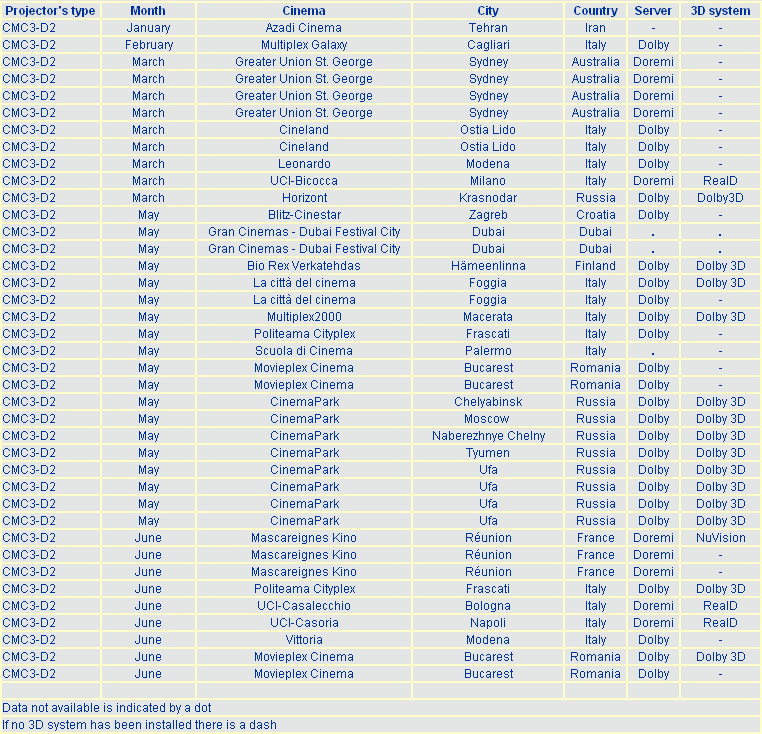
Reg. Trib. Milano n. 418 del 02.07.2007
Direttore responsabile: Elisabetta Brunella
![]()
![]()
International Edition No. 37 - year 3 - 18 June 2008

***
Digitalization
- challenge and threat
 When
the fifth edition of MEDIA Salles’ Course ”DigiTraining Plus
2008” in London wrapped up its five-day-long event, attended by
45 participants from 14 different countries, one item was very clear:
the business plan for (especially) small and medium-sized cinemas in Europe
(and probably also elsewhere) was still far off in a hazy horizon.
When
the fifth edition of MEDIA Salles’ Course ”DigiTraining Plus
2008” in London wrapped up its five-day-long event, attended by
45 participants from 14 different countries, one item was very clear:
the business plan for (especially) small and medium-sized cinemas in Europe
(and probably also elsewhere) was still far off in a hazy horizon.
Parallel to the expected roll-out in the US this year and 2009 basically
nothing or very little happens in Europe apart from in the UK where public
money (The UK Film Council) has equipped almost 300 screens of all sizes
and locations with a 2K installation, with Arts Alliance Media as the
technical partner. Apart from Norway no other country has so far initiated
or even hinted at a similar solution. The situation is causing a lot of
nervousness and bewilderment also because it is hard to see how the VPF
system, now operating in the US, can be “applied” for European
cinemas of smaller size. From the distributors’ point of view “the
business is simply not there” to make it worthwhile.
Arts Alliance Media foresees that 7,000 screens will be helped out by
the VPF system in Europe. What about the rest of Europe’s 20,000
screens? Part of the problem is of course the 2K format implemented by
the DCI criteria (the US majors). An excellent standard, absolutely, that
by far exceeds the needs of an average-sized European screen with 180
seats and a screen width of 8 meters. An expressed expectation that the
Majors would “go easy” on the 2K-demand in overseas territories
like India and China was shot down by XDC, Belgium, represented by Fabrice
Testa. The forecast for surviving is therefore darkish for cinemas that
have to rely on American product.
But also the art-cinemas throughout Europe
are feeling the cold. President of CICAE, Detlef Rossmann, expressed his
worries and looked forward to having a German model (a mix of VPF and
Federal Film Board money) discussed in June with ministers and players
from the industry. “The 1,300 big-chain screens can cope themselves
– the rest, 3,500, will be destroyed”, was Rossmann’s
attitude, “small European distributors cannot pay the same VPF as
the big companies wherefore their films will not be screened. A diversified
VPF might be the answer or a fee per ticket.” No big chain has yet
invested in digital equipment in Germany.
During the course alternative content was presented and discussed galore.
Opera seemed to be the big thing in many UK locations equipped with 2K
projectors. Big and small. Direct transmissions from the Metropolitan
or filmed opera versions from La Scala were extremely popular even at
relatively high-priced tickets like 20 pounds. In a clearly small location,
Hawkhurst in Kent, a small cinema (92 seats) has been installed in the
former town meeting hall and does great business as a 100% digitalized
cinema. Thanks to alternative content, first-run films, flexibility and
diversity, the first cinema ever in this small town has prospered.
The message is clear: solve the financial problem and
the future looks bright. A representative from a major chain in Scandinavia
expressed his vision like this: “the big ones can look after themselves,
the small rural ones will be supported by local governments/state for
cultural reasons – the ones in between that do not have a particular
profile or financial solidity will be left out in the cold”.
Jens Rykær
President
MEDIA Salles
(Per
leggere il testo in italiano cliccare qui)
WOMEN IN DIGITAL CINEMA
Eye balls and Euros - Digital Cinema is at the end of the beginning and
primed for growth
Nancy Fares, Business Manager, Texas Instruments DLP®
Cinema Products
 I
am the Business Manager for DLP Cinema® Products; my role includes
product line responsibilities, Profit and Loss (P&L), product marketing
and overall strategy for the DLP Cinema® Products group. This year
marks the 10th Anniversary of DLP’s entrance into the cinema industry,
with the first fully functional and Hollywood endorsed digital DLP Cinema
movie projector. After years of prototypes, in 1998 DLP delivered Hollywood’s
biggest image critics and cinematographers with a digital projector that
met the world’s highest standards on colour, brightness and reliability
and therefore pioneered the digital cinema concept. A year later, in 1999,
the studios released the first movie in digital format on DLP Cinema,
which was Star Wars: Episode I - The Phantom Menace. DLP Cinema honours
the heritage of the ultimate viewing experience while incorporating the
latest technology innovations, such as the 3D single projector solution
and cutting costs for cinema exhibitors, distributors and ultimately the
consumer.
I
am the Business Manager for DLP Cinema® Products; my role includes
product line responsibilities, Profit and Loss (P&L), product marketing
and overall strategy for the DLP Cinema® Products group. This year
marks the 10th Anniversary of DLP’s entrance into the cinema industry,
with the first fully functional and Hollywood endorsed digital DLP Cinema
movie projector. After years of prototypes, in 1998 DLP delivered Hollywood’s
biggest image critics and cinematographers with a digital projector that
met the world’s highest standards on colour, brightness and reliability
and therefore pioneered the digital cinema concept. A year later, in 1999,
the studios released the first movie in digital format on DLP Cinema,
which was Star Wars: Episode I - The Phantom Menace. DLP Cinema honours
the heritage of the ultimate viewing experience while incorporating the
latest technology innovations, such as the 3D single projector solution
and cutting costs for cinema exhibitors, distributors and ultimately the
consumer.
As we celebrate our 10th year in the film industry, DLP Cinema projection technology is installed in over 6,000 theatres on every continent except Antarctica. Today there are more than 1,200 theatres that offer the digital 3D experience powered by DLP Cinema technology, and this number will continue to increase as more DLP projectors are deployed globally.
It was over ten years ago that Texas Instruments and other companies began working on digital cinema and today we’ve reached the point where we have a viable market. While a little less than five percent of the world’s cinema screens have been converted to digital projection, it is fair to say that we have now arrived at the end of the beginning. Of the early adopters, approximately 75 percent of digital cinemas are in North America, with the rest split between Europe and Asia. It’s been a decade in the making, but we are finally past the point of beta testing and committees deciding standards.
It could be argued that the slow take-up of digital projection technology has been due to the need to agree to standards, to test equipment, and so on. However, it’s more likely that the primary reason why the pace of product development in digital projection technology has been slow is because the true cost and benefits of digital cinema to the main interested parties – equipment manufacturers, film distributors and exhibitors – are not reliably known or properly understood. The lack of solid facts about the economics of digital cinema has led to a very long game of poker. Such games aside, the long term picture looks rosy for exhibition, distribution and equipment manufacturers. Ultimately, it will become more viable to show movies to much larger audiences since digital prints cost less, require less handling, and offer far more flexibility in programming.
DIGITRAINING PLUS 2008
European Cinemas Experiencing New Technologies
London, 9 - 13 April 2008
![]()
On our website:
Speakers' presentations
The power point presentations can be downloaded by clicking on the
names of the speakers in the course
programme.
Photo gallery
This photo gallery records some of the high points of the Course, together
with shots of all the those who took part in this initiative designed
to spread knowledge and competences in the field of digital cinema for
European exhibitors.
To see the photo gallery, please click
here
Cannes Film Festival 2008:
European Films and European Cinemas in the forefront at the Schermi
di Qualità - MEDIA Salles joint event


On 20 May the President of MEDIA Salles, Jens Rykaer, and the Secretary General, Elisabetta Brunella, presented the latest figures on cinema-going in Europe in 2007, published in the Newsletter European Cinema Journal 1/2008.
To read the Newsletter European Cinema Journal 1/2008, please click here.
To see the photos of the event,
click here.
(Per
leggere il testo in italiano cliccare qui)

The CD Rom of the MEDIA Salles
European Cinema Yearbook - 2007 final edition -
including the situation of the digital projectors installed worldwide
as at December 2007
will be available at the Cinemeccanica stand (no. 223)
at Cinema Expo (Amsterdam, 23 - 26 June 2008).
 Tero
Koistinen on the executive committee of MEDIA Salles
Tero
Koistinen on the executive committee of MEDIA Salles On 22 May, during the meeting held
in Cannes, Tero Koistinen became a member of the MEDIA Salles Executive
Committee.
Tero Koistinen, who has played an active role in the Association's activities
for many years and has followed all five editions of the DigiTraining
Plus course, is currently Director of the Finnish Cinema Exhibitors' Association.
Glyndebourne operas will go across the globe thanks to a new partnership with More2screen
Glyndebourne and London-based alternative content distributor, More2Screen, have just announced an exclusive agreement aiming at organising 85 cinema screenings in the UK, Europe and North America, starting this Autumn.
The programme will include three specially-selected operas to run in October, November and December only in High Definition and 5.1 sound. The titles already announced are La Cenerentola and Giulio Cesare.
The agreement with More2Screen represents a development of the initiative already carried out in 2007 when Glyndebourne became the first UK opera house to screen opera at cinemas across the country, totalling 31 screenings that were well received by audiences.
 Christine
Costello, co-founder (with Penny Nagle) of More2Screen said:
Christine
Costello, co-founder (with Penny Nagle) of More2Screen said:
“We’re delighted to be working with such a distinctive, creative and high quality brand in the world of opera. Cinema audiences all over the world will be enthralled by the Glyndebourne experience, representing as it does the very best of the genre”.
Christine Costello participated as a lecturer at the “DigiTraining
Plus 2008: European Cinemas Experiencing New Technologies” course
(London, 9 – 13 April 2008).
To view her presentation,
click here
Interview with Lorenzo
Branca,
Director of Digital Cinema, Cinemeccanica –
Milan
 A
graduate in electronic engineering from the University of Pavia, Lorenzo
Branca has been with Cinemeccanica since 2004 and coordinates projects
for the development and installation of digital projection systems in
cinemas.
A
graduate in electronic engineering from the University of Pavia, Lorenzo
Branca has been with Cinemeccanica since 2004 and coordinates projects
for the development and installation of digital projection systems in
cinemas.
How do you view the development of digital cinema?
Following a slowdown towards the end of 2007, I have noticed a considerable
recovery, both in actual installations and in contacts with new clients
in the first few months of 2008.
What do you think this increased interest by exhibitors is due to?
Without doubt to the greater availability of product: on the market there
are more films distributed in digital format and more alternative content.
But it is the spread of 3D that has given such a boost.
Cinemeccanica operates internationally: from your privileged observation
point, do differences emerge between the various markets in relation to
the development of digital and the economic models that support it?
As regards financing, in Italy there are high expectations of public institutions,
whilst the VPF model that has been adopted on a wide scale only in the
United States is considered with some perplexity. This is mainly for “cultural”
reasons: the exhibitor wishes to continue owning his equipment. The figure
of the intermediary, the so-called “integrator”, foreseen by VPF, risks
being considered an extra link in the supply chain and one whose usefulness
is not acknowledged.
(Click here to read the whole article)
(Per
leggere il testo in italiano cliccare qui)
Cinemeccanica digital projectors installed since the beginning of 2008


Group of participants at the DigiTraining Plus 2008
New MEDIA Salles offices
On 30 June 2007 MEDIA Salles relocated
its offices to the Milan headquarters of Agis, Italy’s entertainment
industry association.
Our new address is:
MEDIA Salles
c/o Agis Lombarda
Piazza Luigi di Savoia, 24
I-20124 Milano
Tel. +39 02 6739781 Direct line +39 02 67397823
Fax +39 02 6690410
E-mail: infocinema@mediasalles.it